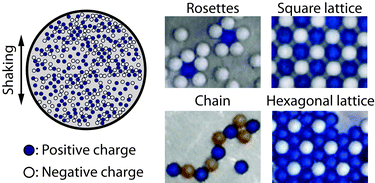Rebecca Cademartiri, Claudiu A. Stan, Vivian M. Tran, Evan Wu, Liam Friar, Daryl Vulis, Logan W. Clark,
Simon Tricard and George M. Whiteside
http://pubs.rsc.org/en/content/articlepdf/2012/sm/c2sm26192h
Millimeter sized polymer objects were enclosed into a container and
agitated, which caused the polymers to charge through contact
electrification and self-assemble reproducibly. This self-assembly
depended on a number of variable including material, size, and shape of
container (eg. aluminum, Nylon, teflon, PMMA) and polymers (eg. Nylon,
teflon, polyamideimide, HDPE, PP, PS); type, amplitude, and frequency of
agitation; and number of spheres of each type of polymer. The group
classified three types of structures as crystals, chain, and rosettes,
and self-assembly also seemed to play a role in electrical charge of the
objects.


No comments:
Post a Comment